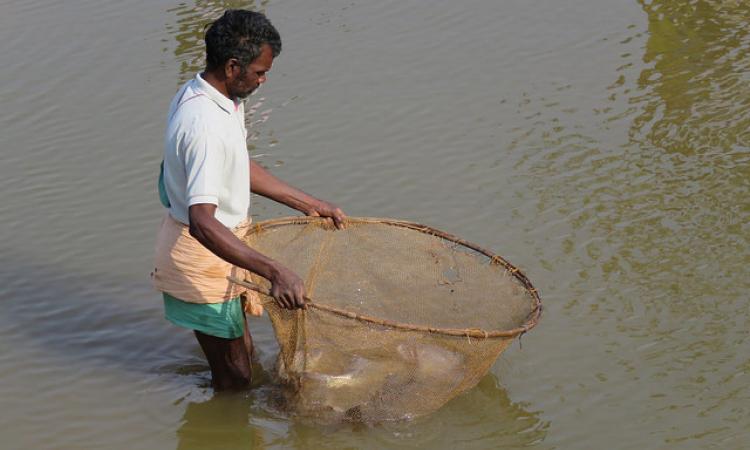
Lower Gangetic Plains of West Bengal is blessed with a variety of wetlands ranging from coastal and marine wetlands to inland freshwater lakes, dams and swamps as well as the constructed wetlands in irrigation schemes and sewerage treatment systems and also the mountain wetlands. The inland freshwater wetlands, oxbow lakes and swamps are sources of livelihood for many people of rural West Bengal.
The wetlands, besides serving ecological functions, provide livelihood security to inhabitants around them. Moreover, wetlands are an imperative part of a nation’s economy.
Extensive floodplain wetlands of West Bengal bear special significance in the inland fisheries of India because of the support they provide to livelihoods of millions. In spite of the vast area they cover, fish yield is generally much lower than their potential. Out of the vast area (0.42 l ha) of wetlands in the state, only 12.5 percent could be brought under scientific fisheries management practices which could realise 0.399 mt productivity against its potential of 1.05 mt. Although the technology for fish culture is available but its horizontal expansion was not achieved due to certain pressing socio-governance issues. The situation is complex and needs the balance to set the equilibrium in social, economical and political spheres. 
Issues that hinder wetland fisheries
Encroachment and loss of river connectivity: Rural development programmes were implemented, perhaps with good intention, but had many undesirable consequences. Continued destruction of wetlands especially by encroachment and commercial activities ultimately affect wetland fisheries. Merciless exploitation of wetlands in the name of development has had consequences like drying, eutrophication, biodiversity loss, rapid ageing and in some cases, extinction of this invaluable resource. This is one of the main things that hampers culture-based fisheries in wetlands. In addition to these, there is also siltation in wetlands due to the loss of river connectivity.
Conflict with agriculture sector: Water tables of wetlands are gradually becoming shallow due to limited rainfall and loss or feeble connectivity which has led to conflict among stakeholders regarding its use--for fisheries, irrigation and agriculture. Conflict with agriculture sector is also identified as one of the major problems for wetland fisheries development. Here is a lowdown on various kinds of conflicts.
Fisheries and dry season agriculture
The wetlands shrink during the summer season when the water area gets reduced. The banks of the wetlands/beel/baor are used for dry season agriculture. Sometimes shallow beels are dewatered for summer season agriculture. The beels connected with rivers are controlled with sluice gates and sometimes embankments are also made. These arrangements are made to get better economic return through crop farming. However, they affect the fisheries--both immediately and in the long run. The fishers loss their livelihood due to reduced access to and control over the wetlands as they belong to the lower strata of the society.
Fisheries and boro cultivation
West Bengal ranks first in rice cultivation and contributes 14 percent of the total production in the country. Boro rice, the rice sown in winter and harvested in summer, is one of the major crops of the state. Water is drawn from the wetlands/beels through lift irrigation pumps for irrigating boro paddy in the adjacent land. As a result, during summer season, the water level goes down drastically, causing water quality to deteriorate. Therefore, the fishers consider the period between the onset of summer (March) till the arrival of monsoon (August) as the ‘fallow period’.
Jute retting and wetland fisheries
Wetlands are also used for jute retting. The practice is abusive or deteriorative and is detrimental to wetland fisheries. At the onset of monsoon, wetlands are commonly used for jute retting. The practice deteriorates water quality considerably because of the release of obnoxious gases and the sudden rise in organic load, which render wetlands unsuitable for fisheries.
Lack of awareness in the use of sustainable fish production system: Enclosure technique, called pen culture, can do wonders in wetland fisheries development in West Bengal, but it is not adopted due to lack of awareness among wetland fishers.
Governance and institutional arrangements: Wetlands are very unique natural resources which provide a wide variety of benefits to the society. Such open water resources are used by multiple stakeholders. Overlapping interest and conflict often lead to chaos. Wetlands are extremely important ecosystem in terms of fish abundance, diversity and productivity. Many important fish species use wetlands for shelter and as a breeding and feeding ground. Scientific management of the wetlands is necessary for the conservation of biodiversity as well as for supporting the livelihood of fishers. But, a lack of proper governance mechanisms and institutional arrangements for sustainable use of wetlands and scientific management also impede the growth of wetland fisheries. Moreover, leasing policy of the beels become a threat of fishermen cooperative societies as the lease amount is very high.
Strategies to overcome the issues
Developmental activities are important for a nation but there is a need to redesign the strategy and approach to help our rural society to march on the desired path of development.
Conflict around wetland use can be resolved through local self governance, technological intervention and infrastructure improvement to increase water in the wetland. Organising regular meetings, frequent inspections and guidance by the agriculture, irrigation and fishery experts to improve the situation can also help resolve the conflicts. The use of centrally-funded scheme like MGNREGA should be encouraged. Improved jute retting and extraction technology can also minimise conflicts.
More outreach activities are necessary to reach everyone involved. More number of field training and demonstrations are needed to build awareness and skills around the use of sustainable wetland management tools among stakeholders to bridge the knowledge/skill gap existing in the sector.
Wetlands are governed by different agencies and are used by different stakeholders. Therefore, central management and monitoring are ways to ensure effective governance. Strong monitoring system is essential as wetlands are very dynamic--changing annually, sometimes even monthly or daily.
/articles/conflict-around-wetland-use-west-bengal